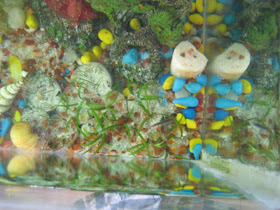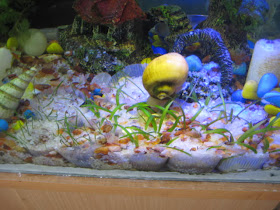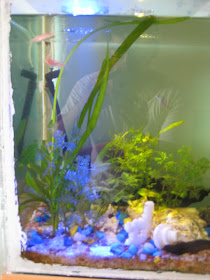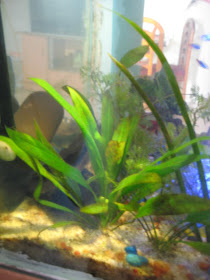Aquarium after 1 Month without water change.
After some interesting results of growing Aquarium plants in fine gravel. I moved my attention to try out the Low-Tech Walstad Method.
The Setup:
Here is the under gravel setup:
As you can see in the above image, I have created a L-shape boundary using some scrape marble stones. Aquarium plants would be planted inside this L-shaped Boundary. The boundary is 1 inch in height. This boundary was filled with red soil and normal organic fertilizer (30:60 ratio). So far there is no water in the aquarium.
Organic fertilizer is the one we get in packets in a normal outdoor plant nursery.
Once the above setup was complete, it was covered with gravel. I preferred the fine white gravel to cover the L-shape and coarser gravel at other places where I wont be planting any aquarium plants.
Planting Aquarium plants:
Just dig up a small hole in the L-Shaped gravel area and plant your aquarium. See to it that the gravel forms a half inch covers on the soil. If you don't cover the soil then the water will get muddy once you add water to the aquarium.
The white gravel cover stops the soil from getting into the water column, thus avoiding the water to get red(due to red soil)/muddy.
Adding Water and Fishes:
Once you have planted all your aquarium plants, you can start pouring water. See to it that your gravel cover on the soil is not disturbed.
Fill up almost 70% of the water. Now you can arrange/add the stones and other aquarium ornamental stuff inside the aquarium.
You can then let the fishes inside the aquarium.
Here are some more images of the arrangement after 1 month. I forgot to take pics when the first setup was done.
Points to note:
1. The layout of plants is not that great. Need to check up aquascaping concepts.
2. The tall grass kind of plant is showing no signs of growth. It has been in this state for almost 3-4 months now.
3. Amazon and Anubias seems to be thriving good. Cabomba is also showing good growth.
4. Cabomba has a weak stem. Try to keep them in water as long as possible. Ideally plant them at the last, just before filling up the aquarium with water. If you keep them our of water for long in a bend state, they form natural bend for which I do not have a cure. All the new shoots should be fine and will be pointing straight upwards.
5. Once the plants are planted and water has been filled. you cannot change the location of the plant since it will expose the soil and will make the water muddy. It can be a messy experience.
6. I had a problem of Brown Algae in all the previous aquarium setup. That problem is now in control. This could be due to Walstad method or due to less number of fishes (3-Danny and 1 Snail).
























